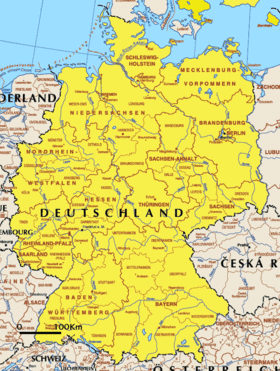Difference between revisions of "Marine Biotechnology in Germany"
(→Overarching science strategies, plans and policies) |
(→Overarching science strategies, plans and policies) |
||
| Line 10: | Line 10: | ||
At the federal level: | At the federal level: | ||
| − | * Federal Government adopted the '''“National Research Strategy BioEconomy 2030 – Our Route towards a Biobased Economy"'''<ref name="bmf">http://www.bmbf.de/pub/bioeconomy_2030.pdf </ref>. | + | * Federal Government adopted the '''“National Research Strategy BioEconomy 2030 – Our Route towards a Biobased Economy"'''<ref name="bmf">http://www.bmbf.de/pub/bioeconomy_2030.pdf </ref>. |
* '''High-Tech-Strategy 2020''' for Germany from German Federal Government<ref name="hig">http://www.hightech-strategie.de/en/index.php </ref> | * '''High-Tech-Strategy 2020''' for Germany from German Federal Government<ref name="hig">http://www.hightech-strategie.de/en/index.php </ref> | ||
Revision as of 14:45, 5 March 2013
Go back to: Home > Strategies, Policies and Programmes > European countries
Overarching science strategies, plans and policies
There are no specific Marine Biotechnology strategies, plans or policies in Germany (yet). Up to now, marine biotechnology is supported as part of more overarching bio-economy and marine/maritime research strategies as described in different documents, including At the federal level:
- Federal Government adopted the “National Research Strategy BioEconomy 2030 – Our Route towards a Biobased Economy"[1].
- High-Tech-Strategy 2020 for Germany from German Federal Government[2]
- Technology Campaign (Innovationsstrategie) of the Federal Ministry of Economics and Technology (BMWi)[3]
- Nationaler Masterplan Maritime Technologien (NMMT)[4]
- “Nächsten Generation biotechnologischer Verfahren – Biotechnologie 2020+ _ synthetische Biologie und zellfreie Biotechnologie“ [5]
At the regional level:
- “Sea or Future” initiative of state Schleswig-Holstein[6]
- A specific and new a regional development strategy Masterplan Marine Biotechnology Schleswig-Holstein is being developed and should be launched by the end of 2012.
Research funding schemes and programmes
Marine Biotechnology research activities may be supported under various programmes including:
- Next-Generation Maritime Technologies a programme of the Federal Ministry of Economics and Technology (BMWi) [7]
- Framework Programme Biotechnology a programme of the Federal Ministry of Education and Research (BMBF) [8]
- Framework Programme Research for Sustainable Development (FONA) a programme of the Federal Ministry of Education and Research (BMBF) managed by Julich (PJT)[9]
- Innovationsinitiative industrielle Biotechnologie a programme of the Federal Ministry of Education and Research (BMBF) [10]
- Basistechnologien für eine nächste Generation biotechnologischer Verfahren a programme of the Federal Ministry of Education and Research (BMBF) [11]
- e:Bio – Innovationswettbewerb Systembiologie a programme of the Federal Ministry of Education and Research (BMBF) [12]
- Renewable Energy a programme of the Federal Ministry for the Environment, Nature Conservation and Nuclear Safety (BMU) as part of the Federal Government's 6th Energy Research Programme [13]
- Marine Research a programme of the Federal Ministry of Education and Research (BMBF) [14]
- Polar Research a programme of the Federal Ministry of Education and Research (BMBF) [15]
- Research for Sustainable Development a programme of the Federal Ministry of Education and Research (BMBF) [16]
- “BioRegio-Wettbewerb” (1997 bis 2005)[17]
- "BioFuture" (Start 1998)[18]
- “KMU-innovativ: Biotechnologie – BioChance“[19]
- BioChancePLUS (2006-2011)[20]
- "Biotechnologie - Chancen nutzen und gestalten" (2001-2010)[21]
- "GO-Bio" im Rahmenprogramm "Biotechnologie - Chancen nutzen und gestalten"[22]
Private funding mechanisms
Research priorities for marine biotechnology research
- Aquaculture
- Bio-based industries
- Industrial biotechnology
- Human health
Strategic documents
- Masterplan Marine Biotechnology Schleswig-Holstein – a regional development strategy (Nov 2012)
- Nationaler Maritimer Masterplan [25]
Infrastructures and coordination and support capacities / initiatives
- In 2012, Germany operates 12 local/coastal vessels from 12,5m to 32,5 m; 8 regional vessels from 38,58m to 54,59m; 3 oceanic from 60,7m to 64,5m and 4 global vessels from 73m to 118m registered at the European Research Vessels Infobase [26].
- In 2012, Germany maintains about 13 large marine research equipments registered in the European large Exchangeable instruments database [26].
- Key aquaculture experimental and research facilities in Germany include
- MAREE (Leibniz Gemeinschaft)
- BIO Deutschland: BIO Deutschland has set itself the objective of supporting and promoting the development of an innovative economic sector based on modern biosciences[27].
- Norgenta North German Life Science Agency GmbH: Norgenta is the project and service company of Hamburg and Schleswig-Holstein that supports life science activities in North Germany[28].
- BioCon Valley: BioCon Valley is the initiative for Life Science and health economy of Mecklenburg-Vorpommern, Germany[29].
- Fraunhofer Research Institution for Marine Biotechnology: This Fraunhofer institution in Lübeck is the first one especially for Marine Biotechnology within the Fraunhofer-Gesellschaft.[30].
- Cyro-Brehm: The „German cell bank for wildlife“ is a biomaterial bank specialized on the archival cryogenic storage of propagatable cell cultures from wildlife[31].
- GEOMAR I Helmholtz Centre for Ocean Research Kiel: GEOMAR is one of the world’s leading institutes in the field of marine sciences[32].
Major initiatives
- Cluster of Excellence "The Future Ocean" [33]
Major observations, trends and future prospects
In Germany there is a strong focus on Biotechnology, but very little is exclusively targeting marine biotechnology. This may change with the first specific regional development strategy for Marine Biotechnology: the Masterplan Marine Biotechnology Schleswig-Holstein (Nov 2012).
References
- ↑ http://www.bmbf.de/pub/bioeconomy_2030.pdf
- ↑ http://www.hightech-strategie.de/en/index.php
- ↑ http://www.bmwi.de/English/Navigation/Service/publications,did=388738.html
- ↑ http://www.bmwi.de/BMWi/Redaktion/PDF/Publikationen/nationaler-masterplan-maritime-technologien,property=pdf,bereich=bmwi,sprache=de,rwb=true.pdf
- ↑ http://www.biotechnologie2020plus.de/BIO2020/Navigation/DE/Vision/strategieprozess.html
- ↑ http://www.schleswig-holstein.de/MWAVT/DE/Technologie/LandesinitiativeZukunftMeer/Ziele/Ziele_node.html
- ↑ http://www.ptj.de/index.php?index=624
- ↑ http://www.ptj.de/index.php?index=588
- ↑ http://www.fona.de
- ↑ http://www.ptj.de/innovationsinibio
- ↑ http://www.ptj.de/biobasis
- ↑ http://www.ptj.de/e-bio
- ↑ http://www.ptj.de/index.php?index=636
- ↑ http://www.ptj.de/index.php?index=626
- ↑ http://www.ptj.de/index.php?index=627
- ↑ http://www.ptj.de/index.php?index=633
- ↑ http://www.itas.fzk.de/tatup/051/dohs05a.htm
- ↑ http://www.ptj.de/biofuture/
- ↑ http://www.bmbf.de/foerderungen/10759.php
- ↑ http://www.ptj.de/lw_resource/datapool/_items/item_2673/biochanceplusbekanntmachung2006.pdf
- ↑ http://www.bmbf.de/foerderungen/12715.php
- ↑ http://www.bmbf.de/foerderungen/12715.php
- ↑ http://www.volkswagenstiftung.de/index.html?L=1
- ↑ http://www.fritz-thyssen-stiftung.de/home/?no_cache=1&L=1&cHash=117adf62f5979fb5992654769d2e7644
- ↑ http://www.bmwi.de/BMWi/Redaktion/PDF/Publikationen/nationaler-masterplan-maritime-technologien,property=pdf,bereich=bmwi,sprache=de,rwb=true.pdf
- ↑ 26.0 26.1 http://www.eurocean.org
- ↑ http://www.biodeutschland.org/
- ↑ http://www.life-science-nord.net/lsn-international/norgenta-gmbh/
- ↑ http://www.ls.bcv.org/hosting/bcv/website_en.nsf/urlnames/bcv_index_EN?OpenDocument&mnu=bcv_index&submnu=
- ↑ http://www.emb.fraunhofer.de/en.html
- ↑ http://www.emb.fraunhofer.de/en/Uebersichtsindex/cellbank_cryo-brehm.html
- ↑ http://www.geomar.de/en/
- ↑ http://www.futureocean.org/en/index.php
Disclaimer
This draft country profile is based on available online information sources and contributions from various country experts and stakeholders. It does not aim nor claim to be complete or final, but should be considered as a dynamic and living information resource that will be elaborated, updated and improved as more information becomes available, including further inputs from experts and stakeholders.
